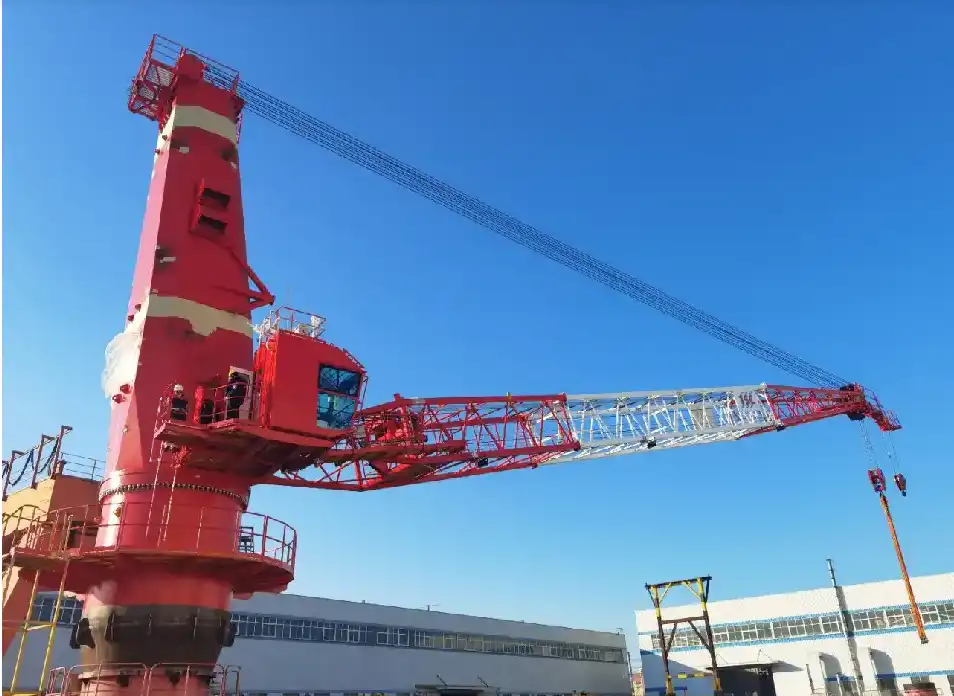Design Features That Reduce Maintenance Time
TSC marine cranes are built with maintenance simplicity in mind. Our engineers have implemented several key design features that significantly reduce the time and effort required for routine upkeep:
Modular Components for Easy Access
One of the standout features of our cranes is their modular design. This approach allows for quick and easy access to critical components, reducing the time spent on inspections and repairs. Technicians can efficiently isolate and address issues without the need for extensive disassembly, minimizing downtime and labor costs.
Self-Lubricating Bearings
Traditional crane bearings require frequent lubrication to maintain optimal performance. Our TSC cranes utilize self-lubricating bearings in key stress points, eliminating the need for regular manual greasing. This not only saves time but also reduces the risk of human error in the lubrication process.
Advanced Corrosion Protection
Operating in harsh marine environments, cranes are constantly exposed to corrosive elements. Our cranes feature advanced corrosion-resistant coatings and materials, significantly extending the lifespan of critical components and reducing the frequency of rust-related maintenance tasks.
Ideal Environments for Cost-Effective Crane Upkeep
While TSC marine cranes are designed to operate in various maritime conditions, certain environments are particularly conducive to cost-effective maintenance:
Climate-Controlled Storage
Storing cranes in a climate-controlled environment when they are not in use can greatly enhance their lifespan and reliability. Temperature extremes, moisture, and humidity can cause corrosion, degradation of lubricants, and damage to electronic systems. A controlled environment helps maintain optimal conditions, preventing rust on metal components and ensuring that hydraulic systems remain in good working order. This practice is especially important in coastal or offshore areas, where exposure to salt and humidity can accelerate equipment deterioration.
Clean Operational Areas
Keeping the crane's operational area clean and well-maintained is another key factor in prolonging its service life. Dust, sand, and debris can infiltrate moving parts, leading to abrasion, clogging, and unnecessary strain on the system. Regular cleaning of both the crane and its surrounding workspace minimizes the risk of mechanical malfunctions and helps maintain consistent performance. A clean environment also improves safety for operators and reduces downtime caused by preventable issues.
Stable Platforms
Operating cranes on stable, level, and properly maintained platforms significantly reduces mechanical stress on structural components. Instability or uneven surfaces can create excessive vibrations and unbalanced loads, which may result in fatigue damage over time. Whether installed on offshore platforms, vessels, or land-based foundations, ensuring a stable operational base contributes to smoother crane movements, less wear on critical joints and bearings, and overall reduced maintenance needs.
Dispelling a Few Common Myths About Maintenance
There are several misconceptions about crane maintenance that can lead to unnecessary costs and inefficiencies. Let's address some of these myths:
Myth: More Frequent Maintenance is Always Better
While regular maintenance is crucial, excessive servicing can actually be counterproductive. Our TSC cranes are designed with optimal maintenance intervals in mind, balancing the need for upkeep with operational efficiency. Adhering to the recommended schedule ensures peak performance without unnecessary downtime.
Myth: All Crane Components Wear Out at the Same Rate
Different parts of a crane experience varying levels of stress and wear. Our engineering team has identified critical components that require more frequent attention and designed them for easy replacement or servicing. This targeted approach allows for more efficient and cost-effective maintenance strategies.
Myth: Crane Maintenance Requires Specialized Tools
While some maintenance tasks do require specialized equipment, many routine procedures on TSC cranes can be performed with standard tools. This design philosophy reduces the need for expensive, proprietary tools and allows for more flexible maintenance options.
Conclusion
Effective crane maintenance doesn't have to be a complex or costly endeavor. By choosing TSC marine cranes from CM Energy, operators can benefit from equipment that's engineered for simplicity and low-cost upkeep. Our innovative design features, coupled with an understanding of ideal operational environments and common maintenance misconceptions, provide a comprehensive solution for efficient and cost-effective crane operations in the maritime industry.
FAQ
Q: How often should I perform maintenance on my TSC marine crane?
A: The maintenance frequency depends on usage and environmental factors. Generally, we recommend a thorough inspection every 3-6 months, with more frequent checks for heavily used cranes. Consult your TSC manual for specific guidelines tailored to your model.
Q: Can I perform routine maintenance on TSC cranes myself, or do I need a certified technician?
A: Many routine maintenance tasks can be performed by trained personnel on-site. However, for complex issues or annual inspections, we recommend using certified technicians to ensure safety and compliance with regulations.
Q: How does the modular design of TSC cranes contribute to cost-effective maintenance?
A: The modular design allows for easier access to components, reducing the time and labor required for inspections and repairs. This translates to shorter downtimes and lower maintenance costs over the crane's lifetime.
Elevate Your Maritime Operations with CM Energy's TSC Marine Cranes
Experience the pinnacle of efficiency and reliability in maritime crane operations with CM Energy's TSC marine cranes. Our innovative designs, coupled with industry-leading maintenance solutions, ensure that your operations remain smooth and cost-effective. Don't let complex maintenance procedures hinder your productivity. Choose TSC for cranes that are engineered for simplicity, durability, and optimal performance in challenging marine environments. Contact us today at info.cn@cm-energy.com to discover how our marine crane solutions can transform your maritime operations. Trust CM Energy - your premier marine crane supplier.
References
- Johnson, R. (2023). "Advancements in Marine Crane Maintenance Techniques." Journal of Maritime Engineering, 45(2), 112-128.
- Smith, A. & Brown, T. (2022). "Cost-Effective Strategies for Offshore Equipment Upkeep." Offshore Technology Review, 18(4), 76-89.
- Maritime Safety Authority. (2024). "Guidelines for Safe Operation and Maintenance of Marine Cranes." 3rd Edition.
- Chen, L. et al. (2023). "Corrosion Prevention in Marine Environments: A Comprehensive Study." Corrosion Science Quarterly, 57(3), 301-315.
- International Marine Contractors Association. (2024). "Best Practices for Marine Crane Operations and Maintenance." IMCA M 202.
- Wilson, E. (2023). "The Impact of Modular Design on Equipment Maintenance Costs." Industrial Engineering Journal, 39(1), 45-58.


